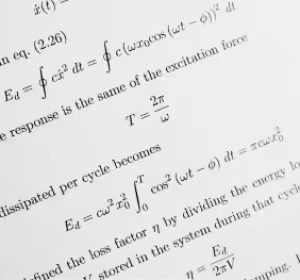More Efficient Research Through AI-Powered Document Analysis
Engineers and researchers waste hours searching through PDFs, Excel sheets, test reports, and material data sheets. AI-powered document analysis makes information instantly accessible, reducing search time, improving efficiency, and enabling data-driven decisions. Discover how Material Intelligence Platforms transforms scattered documentation into valuable insights.
The Problem with Hidden Knowledge in Companies
Decades-old test reports, technical specifications, and standard documents contain valuable insights – yet they often lie dormant in chaotic folder structures, unused. Engineers, researchers, and quality experts lose valuable time every day searching for relevant information in this “dead knowledge.”
Studies show that employees spend up to 2.5 hours daily searching through unstructured data. A massive loss of time – especially for companies that need to make fast, data-driven decisions.
The reasons are clear:
- Unstructured data buried in chaotic folder systems
- Inconsistent file names, making it difficult to find relevant documents
- PDFs and scanned documents that are hard to search
Particularly in material development and quality assurance, valuable insights are hidden in decades-old test reports, standard documents, and technical specifications – often forgotten and unused. However, with AI-powered document analysis, these knowledge sources can be unlocked.
AI as the Key to Material Intelligence
Material Intelligence platforms use Artificial Intelligence (AI) not only to find information in documents but also to put them into a meaningful context. An example is LabV’s AI assistant, specifically developed for the analysis of material and product data.
But how does the AI-powered document search actually work?
– PDF documents are analyzed, broken down into text blocks, and semantically linked
– AI searches relevant documents based on targeted queries
– Key information is summarized and linked to original documents for verification
This allows engineers and researchers to quickly find material properties, test reports, or standards—without manually sifting through countless documents.
From Material Data to Standards: AI as a Research Tool
The potential applications of AI in materials research and quality control are vast—here are some examples:
- Rapid Material Research
Which material properties are relevant for a specific product? AI delivers the answer within seconds, eliminating the need for time-consuming searches through material data sheets. - Comparing Past Test Results
Old test reports can be searched to determine which tests have already been conducted and what the results were. - Direct Access to Standards & Regulations
Need to find equations from a DIN standard related to the crystallization kinetics of polymers? AI provides a precise answer with a direct link to the original document. - Efficient Training & Knowledge Management
New engineers working with unfamiliar lab equipment can simply ask the AI for instructions instead of searching through entire manuals. - Multilingual Document Search
In global teams, AI-powered translation ensures that technical documents in different languages remain searchable and accessible.
Steps for Efficient Document Utilization
A structured document management system is essential to efficiently use and access information. The process consists of four key steps:

- Collect documents
As a first step, all relevant documents are systematically compiled. This includes frequently used reports, manuals, and technical documentation. The aim is to make all important information available at a central location so that it can be found quickly and is not scattered across different systems or storage locations. - Create structure
In order for documents to be used efficiently, they must be divided into useful categories. Grouping by projects, topics or departments ensures clear organization and makes access easier. In addition, a well-thought-out structure improves the performance of AI-powered search functions, as it can deliver relevant answers more quickly. - Ensuring timeliness
In order to obtain accurate and reliable information, only current and relevant documents should be used. Duplicate or outdated files should be sorted out regularly to ensure the quality and efficiency of the database. This ensures that users can access accurate and up-to-date information at any time. - Regular care
Continuous maintenance of the document collection is essential to keep the database up to date and complete. New documents must be added and existing information reviewed. This is the only way the AI-supported search remains reliable and always delivers helpful results.
This structured procedure ensures that documents are not only stored but actively used to make well-founded decisions and to efficiently design work processes.

Top tip
Although AI can search unstructured data, a clear folder structure significantly improves the quality of search results!
Use Knowledge Instead of Searching – with Material Intelligence
LabV combines AI-powered document analysis with structured material data management, enabling a completely new approach to knowledge discovery. Instead of wasting time manually searching through test reports, standard documents, and technical specifications, engineers and quality experts get immediate access to relevant information – precise, contextualized, and linked directly to the original data.
– The LabV AI Assistant: Identifies material properties, analyzes previous test reports, and answers specific questions on standards or specifications – without hours of searching.
– Automated Document Analysis: LabV searches unstructured data, puts it into the right context, and generates clear, structured summaries.
– Integrated Material Data Management: All critical data is centrally organized, structured, and kept up to date – forming the foundation for secure, data-driven decisions.
The business benefits:
– Faster Product Development through instant access to material and test data
– More Efficient Quality Assurance with AI-powered standards and specifications research
– Data-Driven Decisions for R&D and engineering – without inefficient research processes
The Key Advantage: LabV is not a standalone solution but seamlessly integrates into existing IT systems – without costly transitions or lengthy implementation projects. The question is no longer whether AI will be used in material research – but how quickly companies will benefit from LabV.
Want to see how LabV can make your documents AI-ready?
Check out our webinar “From Documents to Knowledge: How AI Unlocks Hidden Value ?” a more detailed description as to what LabV can do with your PDF documents.
